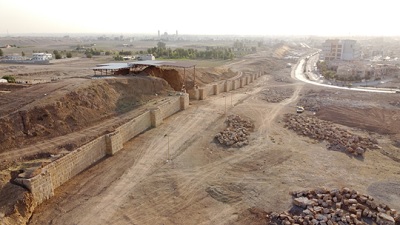East Nineveh, Mosul (Iraq)
Iraqi-Italian Archaeological Mission in Nineveh

Coordinator/Mission Manager
Nicolò Marchetti
Field of research and classifications
Archaeological disciplines from prehistory to the medieval age
ERC: area 10
ERC: SH 6, The study of the human past: archaeology, history and memory
SDGs: 4) Quality education; 11) Sustainable cities and communities; 17) Partnerships for the goals.
Prevalent type of public engagement
Knowledge co-production initiatives; projects to valorise/promote the local area.
Description
Starting in 700 BC, the ancient urban centre of Nineveh served as the capital of the Neo-Assyrian empire following the re-foundation and expansion of the city by King Sennacherib (704-681 BC). An immense low city (750 ha) was organised around two acropolis (Tell Kuyunjiq and Tell Nebi Yunus) and surrounded by a monumental wall (31 m thick and over 12 km long). The main objective of the archaeological mission is to investigate in depth the urban fabric of an ancient Mesopotamian megalopolis, the arrangement of which was hitherto almost completely unknown, through both non-invasive techniques (reconnaissance, geophysical surveys) and extensive excavations. The greatest attention has been paid to the Iron Age, i.e. the final Neo-Assyrian period and the phases immediately following, after the city was conquered and sacked by the combined Mede and Babylonian forces (August 612 BC). The earliest periods are also being studied through targeted surveys. In parallel with the excavations and restoration activities (Isis/Daesh caused terrible damage to the material heritage), an archaeological park open to local and international tourism is being created as part of the larger KALAM project.
Locations and periods
The Iraqi-Italian mission investigations are carried out in the eastern part of the site of Nineveh (36°21’51.3 "N 43°09’33.5 "E), on the left bank of the Tigris River within the urban area of Mosul, Iraq. The archaeological investigations, which started in 2019, take place every year alternately in summer (May-July) or autumn (September-November).
Collaborations and partners
The project, directed by Nicolò Marchetti since it was launched in 2019, is being conducted by the University of Bologna (Department of History and Cultures) in collaboration with the Iraqi State Board of Antiquities and Heritage (SBAH), with numerous officials and archaeologists participating in research activities on the site. The University of Bologna, the Ministry of Foreign Affairs and International Cooperation (DGSP Office VI), the J.M. Kaplan Fund, and the Volkswagen Foundation (for activities relevant to the KALAM project) provide essential financial support.
Objectives and Publics Involved
The main objectives of the archaeological research conducted in East Nineveh include fully understanding the occupation phases of the site and its material culture, studying the bioarchaeological evidence, and creating an archaeological park designed to make the site accessible to the most visitors possible: these include not only members of the scientific and academic community and tourists, but also the communities living near the site who are the real and main users and beneficiaries of the conservation and promotion activities (and who contribute to the project by voicing their views on it).
Target audiences: citizens (adults, but also children and adolescents), schools (students and teachers), heritage professionals.
Impact and evaluation tools
The ongoing archaeological research activity in East Nineveh from 2019 to the present has led to the participation of numerous UNIBO and University of Mosul students and local SBAH officials, giving them the opportunity to experience the excavation, study and documentation of materials. Moreover, collaboration with numerous inhabitants hired as workers during the excavation and creation of the archaeological park led to the full involvement of the communities living near or relatively near the site, making it a point of interest for the city of Mosul not only culturally but also economically.
As far as the results dissemination is concerned, publications to date include scientific articles, presentations at archaeological conferences (ICAANE) and seminars, as well as a series of press articles and television reports showcasing the initial results of the archaeological research.
Despite the limited number of excavation campaigns to date (2019-2022), the archaeological mission in Nineveh has produced a vast amount of new data making it possible to identify the characteristics of the Lower City of Nineveh. The archaeological research and enhancement of the site through the restoration of the monumental walls and creation of the archaeological park are the fruit of continuous interest on the part of institutions such as MAECI and the Iraqi authorities involved (Governorate and Municipality of Mosul, SBAH).
Key words
Nineveh, Iraq, Tigris, archaeological research, archaeological park